The Little Red Hen
Updated: 11 May 2025
41
Once upon a time, in a peaceful countryside, there was a small farm where a cheerful little red hen lived. She had bright red feathers that shone under the sun, and she was always busy from dawn till dusk. The little red hen was known for her hard work and determination. She lived in a cozy little house near the barn, surrounded by fields of green and a beautiful garden full of flowers.
On this farm, the little red hen shared her home with three other animals: a lazy dog named Bruno, a sleepy cat named Cleo, and a playful duck named Dilly. They were all friendly, but they preferred to rest and play rather than help with the farm chores.
One sunny morning, as the little red hen was scratching the ground in her garden, she found something special—a small, shiny seed. She picked it up and examined it closely. “What is this?” she wondered aloud. “Could it be a new kind of food?”
Curious, she took the seed to her friends.
“Who knows what this is?” she asked.
Bruno sniffed it and wagged his tail. “I don’t know,” he said, “but it doesn’t smell like food.”
Cleo stretched and yawned. “It looks like something to plant,” she said sleepily.
Dilly waddled over and quacked, “It looks like a seed. Maybe it will grow into something yummy!”
The little red hen was excited. “I think you’re right, Dilly! This is a wheat seed. If I plant it, it will grow into wheat, and then I can make bread!”
She looked at her friends and asked, “Who will help me plant this seed?”
Bruno lay down in the shade. “Not I,” he said.
Cleo curled up in a ball. “Not I,” she purred.
Dilly splashed in the pond. “Not I,” he quacked.
The little red hen sighed but smiled. “Then I will plant it myself.”
And so, she did. She dug a small hole in the soil, placed the seed inside, covered it with dirt, and watered it carefully. Every day, she tended to the seed, watching it grow taller and stronger.
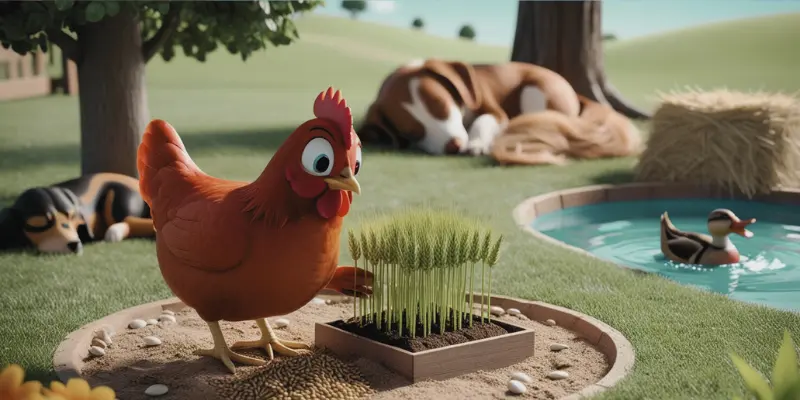
Weeks passed, and the wheat grew high and golden. The little red hen was pleased with her hard work. One day, she looked at the ripe wheat and decided it was time to harvest it.
“Who will help me cut the wheat?” she asked.
Bruno was napping under a tree. “Not I,” he said.
Cleo was grooming herself. “Not I,” she said.
Dilly was chasing butterflies. “Not I,” he quacked.
The little red hen smiled and said, “Then I will cut it myself.”
And so, she did. She carefully cut the wheat stalks and gathered them into bundles. She worked hard under the warm sun, but she didn’t mind. She was proud of what she had grown.
After harvesting, the wheat needed to be threshed to separate the grain from the stalks.
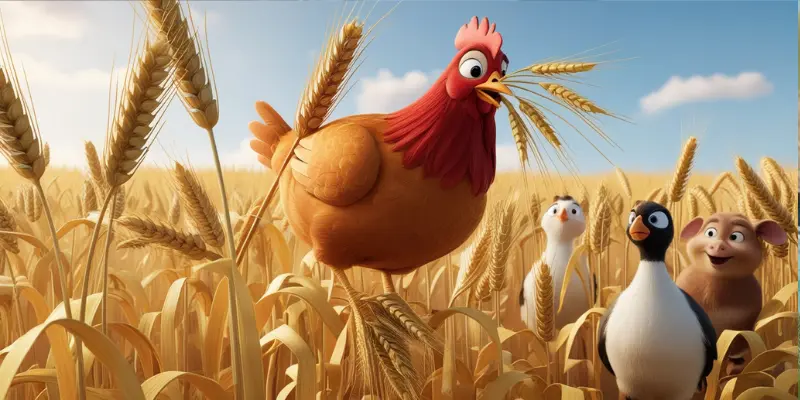
“Who will help me thresh the wheat?” she asked.
Bruno was still resting. “Not I,” he said.
Cleo was still grooming. “Not I,” she said.
Dilly was still chasing butterflies. “Not I,” he quacked.
The little red hen chuckled and said, “Then I will thresh it myself.”
And so, she did. She beat the wheat bundles with a stick, separating the grain from the stalks. It was hard work, but she didn’t mind. She was determined to finish what she had started.
Next, the grain needed to be ground into flour.
“Who will help me take the grain to the mill?” she asked.
Bruno was snoring loudly. “Not I,” he said.
Cleo was still grooming. “Not I,” she said.
Dilly was still chasing butterflies. “Not I,” he quacked.
The little red hen smiled and said, “Then I will take it myself.”
And so, she did. She carried the heavy sack of grain to the mill, where the miller ground it into fine, white flour. She thanked the miller and carried the flour back home.
At home, the little red hen was tired but happy. She had worked hard, and now she was ready to bake bread.
“Who will help me bake the bread?” she asked.
Bruno was still napping. “Not I,” he said.
Cleo was still grooming. “Not I,” she said.
Dilly was still chasing butterflies. “Not I,” he quacked.
The little red hen chuckled and said, “Then I will bake it myself.”
And so, she did. She mixed the flour with water, yeast, and a pinch of salt. She kneaded the dough until it was smooth and soft. Then, she let it rise until it doubled in size. After that, she shaped the dough into a loaf and placed it in the oven to bake.
The smell of fresh bread filled the air, and all the animals in the farmyard came running.
“Who will help me eat the bread?” the little red hen asked.
Bruno’s nose twitched. “I will!” he said.
Cleo’s mouth watered. “I will!” she said.
Dilly’s stomach growled. “I will!” he quacked.
The little red hen smiled and shook her head. “You didn’t help me plant the seed. You didn’t help me cut the wheat. You didn’t help me thresh the wheat. You didn’t help me take the grain to the mill. You didn’t help me bake the bread. So, I will eat it myself.”
And so, she did. She enjoyed every bite of the warm, delicious bread she had made all by herself.
The next day, the little red hen found more wheat seeds and decided to plant them again. This time, she didn’t ask her friends for help. She planted the seeds, watered them, and watched them grow. When the wheat was ready, she harvested it, threshed it, took it to the mill, and baked more bread.
Her friends watched her work and realized how hard she had worked to make the bread. They felt sorry for not helping her before.
“Little red hen,” said Bruno, “we’re sorry we didn’t help you.”
“Yes,” said Cleo, “we should have helped you.”
“We promise to help you next time,” said Dilly.
The little red hen smiled. “Thank you, my friends. Next time, we will work together.”
And so, they did. The next time, when the little red hen planted the wheat, Bruno helped dig the holes, Cleo helped water the plants, and Dilly helped chase away the birds. When it was time to harvest, they all worked together. They cut the wheat, threshed it, took it to the mill, and baked the bread as a team.
From that day on, the little red hen and her friends worked together on the farm. When spring arrived, they planted more wheat seeds in neat rows. Bruno used his strong paws to dig holes in the soil. Cleo carefully dropped in each seed with her gentle paws. Dilly waddled back and forth with a watering can, sprinkling the plants each day.
As the days turned to weeks, green shoots began to poke out of the ground. The friends watched the wheat grow tall and golden under the warm sun. They felt proud of the work they had done together.
One afternoon, the little red hen looked out across the field and said, “The wheat is ready! Let’s harvest it.”
Bruno wagged his tail. “I’ll help cut the stalks!”
Cleo jumped to her feet. “I’ll tie them into bundles!”
Dilly flapped his wings. “I’ll carry the bundles to the barn!”
Working side by side, they harvested the wheat faster than ever before. They laughed, sang songs, and enjoyed being part of something special. When they finished, the barn was full of golden wheat bundles.
Next, it was time to thresh the wheat and separate the grain.
“I’ll beat the stalks,” said Bruno, thumping them with a stick.
“I’ll gather the grain,” said Cleo, collecting the little seeds.
“I’ll clean up the straw,” said Dilly, pushing the dry stalks into a pile.
By evening, they had filled a big sack with fresh wheat grain. Tired but happy, they sat down to rest, knowing they had all done their part.
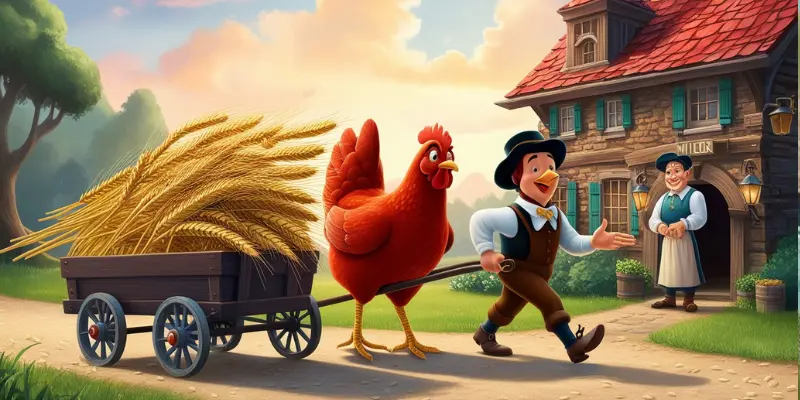
The following morning, the little red hen said, “Now we must take the grain to the mill.”
“I’ll pull the cart,” said Bruno, stepping into the harness.
“I’ll walk beside you and keep you company,” said Cleo.
“I’ll fly ahead and let the miller know we’re coming,” said Dilly.
Together, they made their way down the dusty road to the village mill. The miller, Mr. Grumble, was surprised to see so many helpers.
“Good to see teamwork!” he chuckled. “Your flour will be ready in no time.”
True to his word, he ground the wheat into soft, fine flour and packed it neatly into a clean sack.
The friends thanked him and returned home as the sun began to set. The red hen looked around at her tired but cheerful companions. “Tomorrow,” she said, “we bake.”
The next morning, the kitchen buzzed with excitement.
“I’ll mix the flour and water,” said Bruno.
“I’ll stir in the yeast and salt,” said Cleo.
“I’ll knead the dough!” said Dilly, rolling up his feathers.
The dough was smooth and warm. They placed it in a bowl to rise and covered it with a cloth. After a while, the dough puffed up like a soft pillow.
They gently shaped it into a round loaf and placed it in the oven. The smell of fresh bread filled the air—warm, rich, and mouthwatering. Everyone’s eyes sparkled with excitement.
Finally, the bread came out of the oven, golden brown and steaming hot.
The little red hen placed it on the table and smiled.
“You all worked hard,” she said. “So now we can enjoy the reward together.”
She sliced the bread and gave a piece to each of her friends. They took a bite—and their eyes grew wide.
“This is the best bread I’ve ever tasted!” said Bruno.
“So soft and warm,” said Cleo.
“I want another slice!” quacked Dilly.
The little red hen giggled. “That’s because it was made with care, effort, and love.”
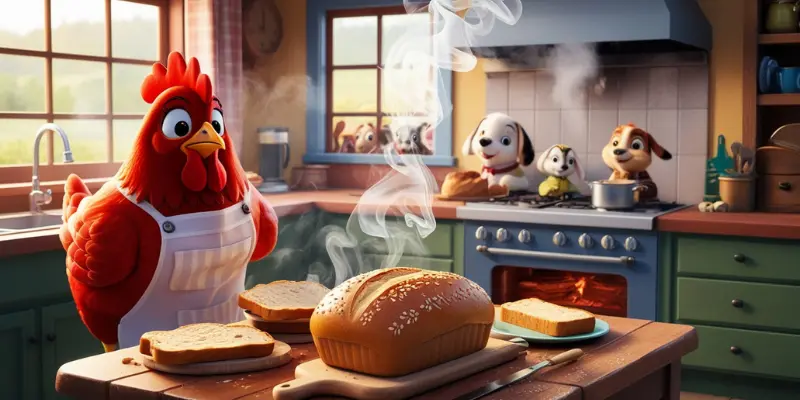
From that day on, everything changed on the farm. Bruno, Cleo, and Dilly never sat around while the red hen worked. They planted, watered, harvested, and baked together. The farm became neater, happier, and full of joy.
Word spread through the countryside about the animals who worked as a team. Other farms visited to learn from them. The red hen became known not only for her delicious bread, but also for the friendship and teamwork that made everything possible.
Each season brought new work—corn in the summer, pumpkins in the fall—but no one worked alone anymore. And every time the oven door opened and the smell of fresh bread filled the air, they gathered at the table as one happy farm family.
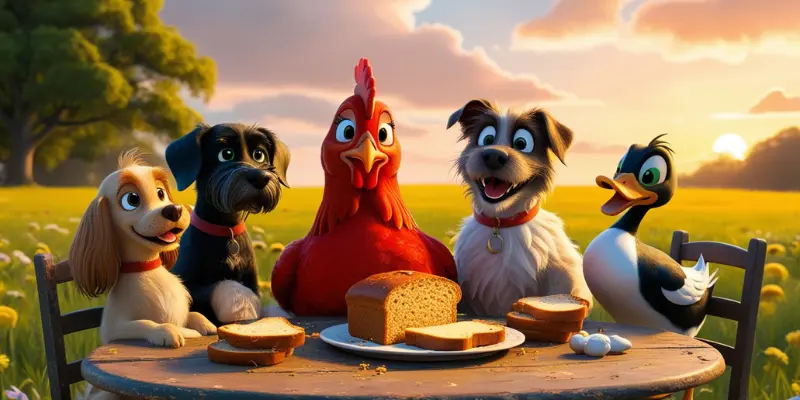
Even the smallest task—watering a seed or tying a bundle—was done with love and shared laughter. They learned that the greatest rewards don’t just come from finishing the work, but from doing it together.
And so, the little red hen and her friends lived happily, sharing the chores and sharing the joy, in a farm filled with warmth, kindness, and the smell of freshly baked bread.
Moral of the Story:
The Little Red Hen teaches us that hard work pays off, and everyone should help if they want to share in the rewards. It also shows the importance of teamwork, responsibility, and not taking others’ efforts for granted.
FAQs About Story
Why did the Little Red Hen do all the work by herself at first?
Because her friends—the dog, cat, and duck—didn’t want to help. She asked them kindly, but they each made excuses. So she decided to do it on her own.
What changed the animals’ minds about helping?
When they saw how much work the Little Red Hen did and how good the bread smelled, they realized it was unfair not to help. They felt sorry and promised to work together next time.
What makes this story special for children?
It teaches kids that teamwork and effort are important. It also shows how doing your part leads to shared happiness—and yummy results like fresh bread!
Please Write Your Comments